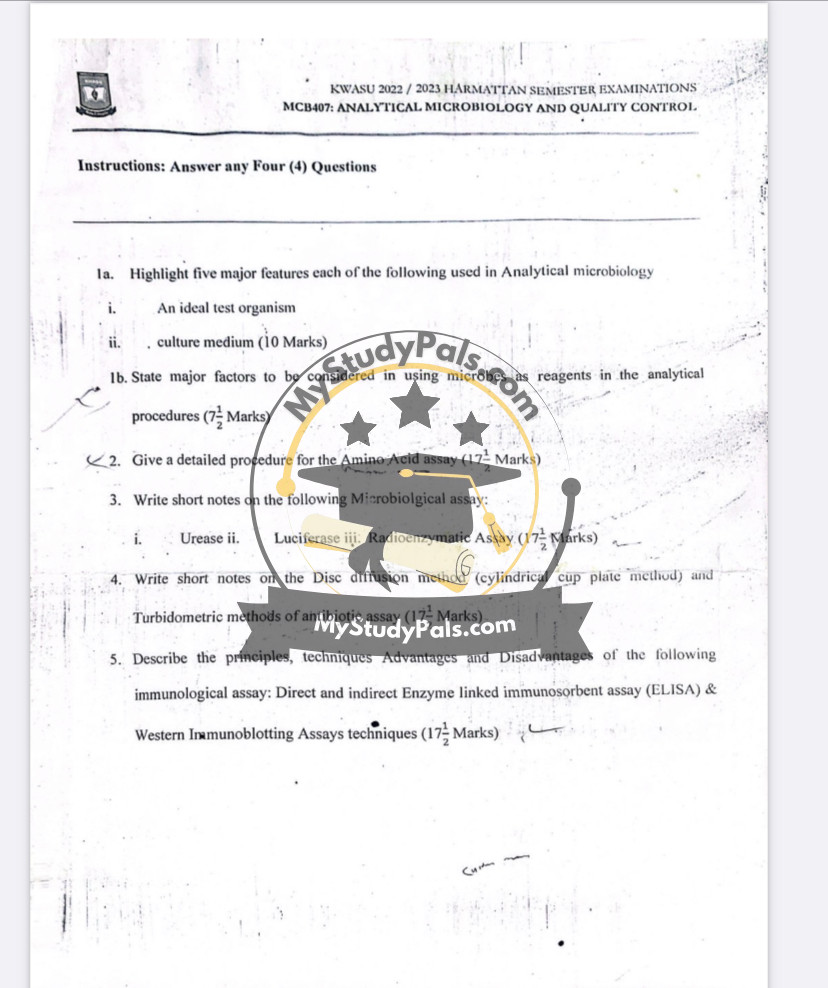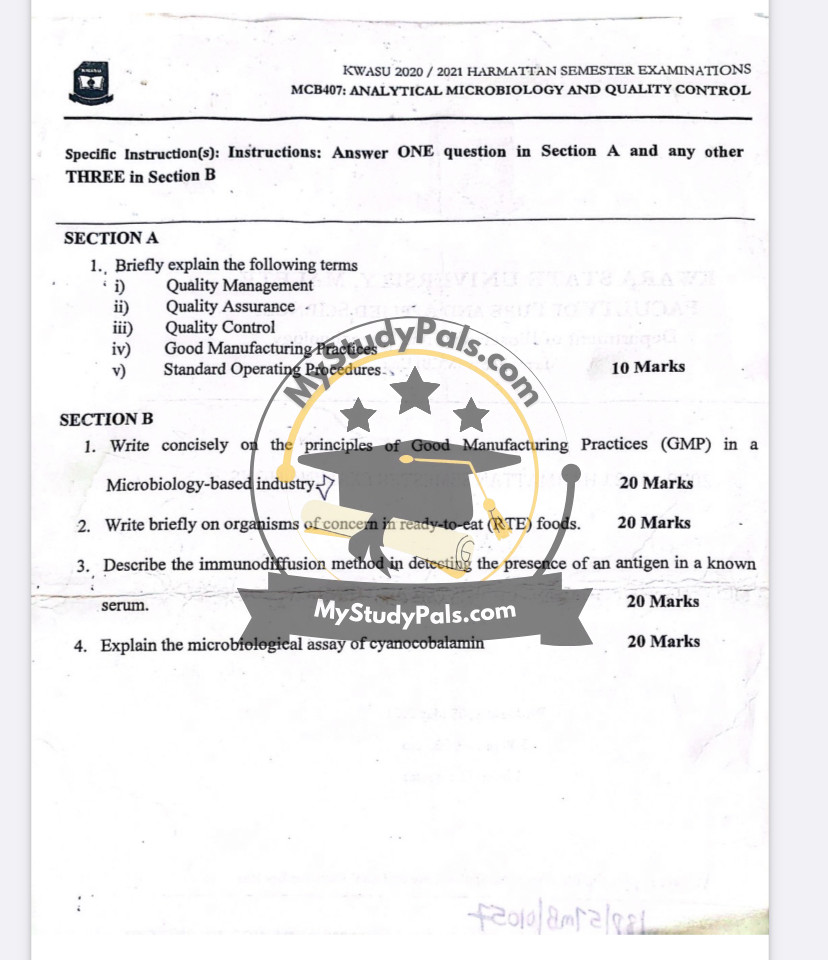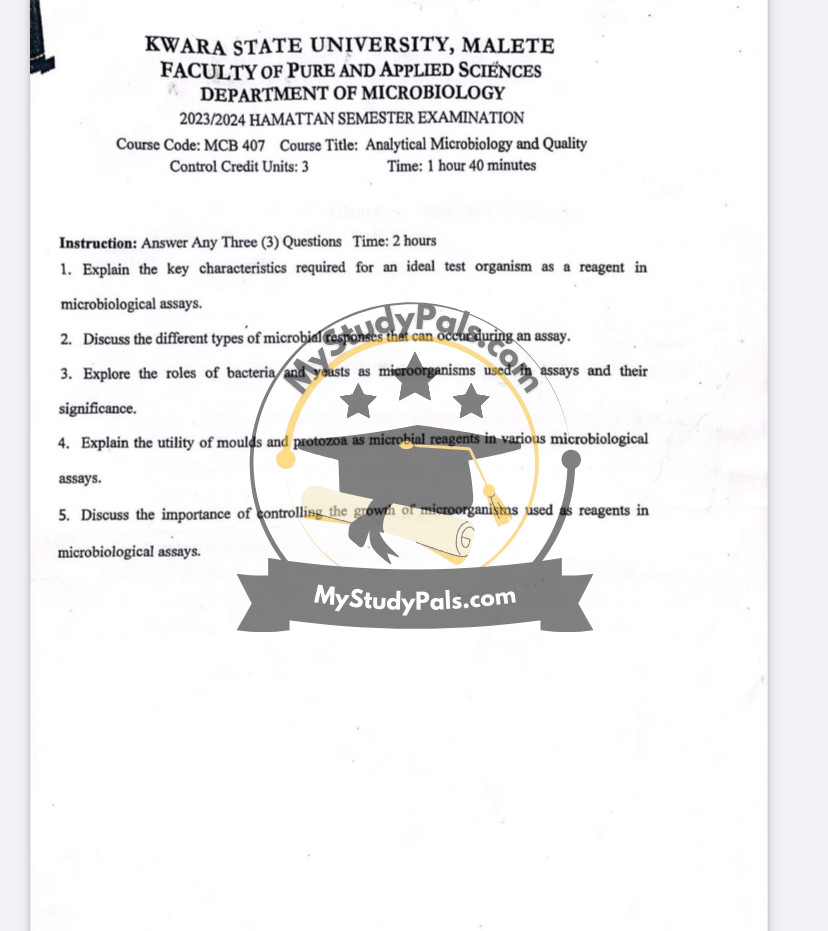ANWSER
Question 1a (i): Highlight five major features of an ideal test organism used in Analytical Microbiology.
Answer:
1. Genetic Stability: The organism should maintain consistent genetic traits to ensure reproducible results.
2. Rapid Growth: It should grow quickly to reduce assay time.
3. Non-pathogenic: The organism must be safe to handle in the laboratory.
4. Sensitivity: It should respond predictably to the analyte being measured.
5. Ease of Cultivation: The organism should be easy to culture under standard laboratory conditions.
Question 1a (ii): Highlight five major features of a culture medium used in Analytical Microbiology.
Answer:
1. Sterility: The medium must be free from contaminants to avoid false results.
2. Nutrient Adequacy: It should provide all essential nutrients for the test organism’s growth.
3. pH Stability: The medium should maintain a stable pH during the assay.
4. Selectivity: It may contain inhibitors to suppress unwanted microbial growth.
5. Clarity: For turbidometric assays, the medium should be clear to allow optical measurements.
Question 1b: State major factors to be considered in using microbes as reagents in analytical procedures.
Answer:
1. Strain Specificity: The microbe must be appropriate for the target analyte.
2. Growth Conditions: Optimal temperature, pH, and oxygen requirements must be met.
3. Standardization: The microbial population and growth phase should be standardized.
4. Sensitivity Range: The organism should detect the analyte within the desired concentration range.
5. Reproducibility: The assay must yield consistent results under identical conditions.
—
Question 2: Give a detailed procedure for the Amino Acid assay.
Answer:
1. Preparation of Test Organism: Use a auxotrophic strain that requires the specific amino acid for growth (e.g., *Lactobacillus* species).
2. Inoculum Preparation: Grow the organism in a nutrient-rich medium, then wash and suspend in a saline solution.
3. Standard Curve: Prepare a series of dilutions of the amino acid standard (known concentrations).
4. Assay Setup: Add the test organism to tubes containing the standard dilutions and the sample. Include a negative control (no amino acid).
5. Incubation: Incubate at optimal temperature (e.g., 37°C) for 18–24 hours.
6. Measurement: Use turbidometry or pH change to measure growth response.
7. Calculation: Plot a standard curve and determine the amino acid concentration in the sample by comparing its response to the curve.
—
Question 3: Write short notes on the following Microbiological assays.
Answer:
i. Urease Assay:
– Measures urea hydrolysis by urease-producing microbes (e.g., *Proteus*).
– Detects ammonia production via pH indicators or spectrophotometry.
– Used in clinical diagnostics (e.g., *Helicobacter pylori* detection).
ii. Luciferase Assay:
– Utilizes the enzyme luciferase (from fireflies/bacteria) to catalyze light emission in the presence of ATP.
– Applications: Microbial viability testing, environmental monitoring.
iii. Radioenzymatic Assay:
– Involves radiolabeled substrates (e.g., ^14C) converted by enzymes into measurable products.
– Highly sensitive; used in hormone and drug metabolite detection.
—
Question 4: Write short notes on the Disc diffusion method and Turbidometric methods of antibiotic assay.
Answer:
Disc Diffusion Method (Cylindrical Cup Plate Method):
– Principle: Antibiotic-impregnated discs inhibit microbial growth on agar, creating zones of inhibition.
– Procedure: Inoculate agar with test organism, place discs, incubate, and measure zones.
– Advantages: Simple, cost-effective, qualitative.
– Disadvantages: Semi-quantitative, affected by agar depth/diffusion rates.
Turbidometric Method:
– Principle: Measures microbial growth inhibition by antibiotics via optical density (OD).
– Procedure: Inoculate broth with organism and antibiotic, incubate, and measure OD changes.
– Advantages: Quantitative, high-throughput.
– Disadvantages: Requires standardized inoculum, sensitive to particulates.
—
Question 5: Describe the principles, techniques, advantages, and disadvantages of Direct/Indirect ELISA and Western Immunoblotting.
Answer:
Direct ELISA:
– Principle: Antigen immobilized on plate; enzyme-linked antibody binds directly.
– Technique: Add sample, primary antibody, substrate; measure color change.
– Advantages: Fast, minimal steps.
– Disadvantages: Low sensitivity, no signal amplification.
Indirect ELISA:
– Principle: Uses secondary antibody (enzyme-linked) to amplify signal.
– Technique: Primary antibody binds antigen, secondary antibody detects primary.
– Advantages: Higher sensitivity, flexible primary antibodies.
– Disadvantages: More steps, potential cross-reactivity.
Western Immunoblotting:
– Principle: Proteins separated by SDS-PAGE, transferred to membrane, detected with antibodies.
– Technique: Electrophoresis, transfer, blocking, antibody probing, chemiluminescence.
– Advantages: Specific, confirms protein size/identity.
– Disadvantages: Time-consuming, technical skill required.
—
Section A Question 1: Briefly explain the following terms.
Answer:
i) Quality Management: Systematic oversight to ensure consistent product/service quality.
ii) Quality Assurance: Proactive processes preventing defects (e.g., SOPs, audits).
iii) Quality Control: Reactive testing of products to meet standards (e.g., microbial assays).
iv) Good Manufacturing Practices (GMP): Regulations ensuring safe, consistent production.
v) Standard Operating Procedures (SOPs): Documented steps for reproducible operations.
—
Section B Question 3: Describe the immunodiffusion method for antigen detection.
Answer:
– Principle: Antigen and antibody diffuse in agar, forming visible precipitin lines.
– Technique (Ouchterlony):
1. Pour agar gel; cut wells for antigen and antibody.
2. Add samples, incubate (24–48 hours).
3. Precipitin lines indicate binding.
– Advantages: Simple, no special equipment.
– Disadvantages: Semi-quantitative, slow.
—
2023/2024 Exam Question 1: Explain key characteristics of an ideal test organism.
Answer:
1. Specificity: Targets only the analyte of interest.
2. Reproducibility: Consistent growth and response.
3. Non-pathogenicity: Safe for lab use.
4. Stability: Maintains traits over generations.
5. Ease of Handling: Grows on standard media.
—




